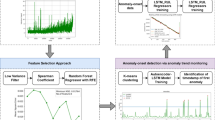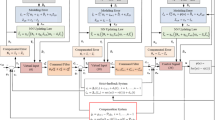Abstract
In this research, two novel online fault detection algorithms are proposed for sensor faults in aircraft. Radial basis function neural network (RBFNN) is used as a fault detection technique, for weight updating parameters adaptive learning rates are used instead of fixed learning rates, two different adaptive learning rate strategies are proposed based on Lyapunov functions which are compared to Extended Kalman Filter (EKF) algorithm. Boeing 747–100/200 aircraft is used for testing and validation of these algorithms. All algorithms have the ability to detect various types of faults such as simultaneous, intermittent, abrupt and incipient with high preciseness and accuracy occur in aircraft sensors. The capability of sensors fault detection of all algorithms are compared, it is proved that all algorithms have the ability to detect faults but Lyapunov function theory II based algorithm is more efficient and having a fast response in faults detection as compared to Lyapunov function theory I and EKF based algorithms. It is also proved that the Lyapunov function theory II based algorithm is more effective in reducing the computational time and computation load.
Similar content being viewed by others
References
Napolitano, M., An, Y., Seanor, B., Pispistos, S., Martinelli, D.: Application of a neural sensor validation scheme to actual Boeing B737 flight data. Proc. Of the AIAA Guidance Navigation and Control Conference. (1999)
Alessandri, A., Caccia, M., Veruggio, G.: Fault detection of actuator faults in unmanned underwater vehicle. Control. Eng. Pract. 7, 357–368 (1999)
G. Heredia, A. Ollero, R. Mahtani, V. Remub and M. Mausial, “ Detection of sensor faults in autonomous helicopters,” proc. of the 2005 IEEE international conference on robotics and automation. Barcelona, Spain, 2005. R. C. baker and B. Charlie, “nonlinear unstable systems”, Int. J. Control., vol. 23, no. 4, pp. 123–145, 1989
Yi, Y., Guo, L., Wang, H.: Adaptive statistic tracking control based on two-step neural networks with time delays. IEEE Trans. Neural Netw. 20(3), 420–429 (2009)
Alvanchi, A., Lee, S., AbouRizk, S.: Modeling framework and architecture of hybrid system dynamics and discrete event simulation for construction. Comput.-Aided Civ. Infrastruct. Eng. 26(2), 77–91 (2011)
Wandekokem, E.D., Mendel, E., Fabris, F., Valentim, M., Batista, R.J., Varejão, F.M., Rauber, T.W.: Diagnosing multiple faults in oil rig motor pumps using support vector machine classifier ensembles. Integr. Comput. Aided Eng. 18(1), 61–74 (2011)
Goupil, P., Marcos, A.: The European ADDSAFE project: industrial and academic efforts towards advanced fault diagnosis. Control. Eng. Pract. 31, 109–125 (2014)
Goupil, P., Boada-bauxell, J., Marcos, A., Rosa, P., Kerr, M., Dalbies, L.: An overview of the FP7 RECONFIGURE project: industrial, scientific and technological objectives. In 9th IFAC symposium on fault detection, supervision and safety of technical processes. 48, 976–981 (2015)
Kiyak, E., Kahvecioglu, A., Caliskan, F.: Aircraft sensor and actuator fault detection, isolation, and accommodation. J. Aerosp. Eng. 24, 46–58 (2011)
Freeman, P., Seiler, P., Balas, G.J.: Air data system fault modeling and detection. Control. Eng. Pract. 21, 1290–1301 (2013)
Castaldi, P., Mimmo, N., Simani, S.: Differential geometry based active fault tolerant control for aircraft. Control. Eng. Pract. 32, 227–235 (2014)
Marzat, J., Piet-Lahanier, H., Damongeot, F., Walter, E.: Model-based fault diagnosis for aerospace systems: a survey. Proceedings of the Institution of Mechanical Engineers, Part G: Journal of Aerospace Engineering. 226, 1329–1360 (2012)
Marzat, J., Piet-Lahanier, H., Damongeot, F., Walter, E.: Control-based fault detection and isolation for autonomous aircraft. Proceedings of the Institution of Mechanical Engineers, Part G: Journal of Aerospace Engineering. 226, 510–531 (2011)
Avram, R.C., Zhang, X., Campbell, J., Muse, J.: IMU sensor fault diagnosis and estimation for quadrotor UAVs. In 9th IFAC symposium on fault detection, supervision and safety of technical processes. 48, 380–385 (2015)
Lu, P., van Kampen, E.-J., de Visser, C., Chu, Q.: Nonlinear aircraft sensor fault re- construction in the presence of disturbances validated by real flight data. Control. Eng. Pract. 49, 112–128 (2016)
Zhang K, Jiang B, Yan X-G, Mao Z. Sliding mode observer based incipient sensor fault detection with application to high-speed railway traction device. ISA Trans 2016
Djeghali N, Djennoune S, Bettayeb M, Ghanes M, Barbot J-P. Observation and sliding mode observer for nonlinear fractional-order system with unknown input. ISATrans 2016
Zhang, D., Wang, Q.-G., YuL, S.H.: Fuzzy-model-based fault detection for a class of nonlinear systems with networked measurements. IEEE Trans InstrumMeas. 62, 3148–3159 (2013)
Ballesteros-Moncada, H., Herrera-López, E.J., Anzurez Marín, J.: Fuzzy model-based observers for fault detection in CSTR. ISA Trans. 59, 325–333 (2015)
Jee, S.C., Lee, H.J., Joo, Y.H.: Sensor fault detection observer design for nonlinear systems in Takagi–Sugeno's form. Nonlinear Dyn. 67, 2343–2351 (2012)
Talebi, H.A., Khorasani, K., Tafazoli, S.: A recurrent neural-network-based sensor and actuator fault detection and isolation _for nonlinear systems with application to the satellite's attitude control subsystem. Neural Network IEEE Trans. 20, 45–60 (2009)
Chen, M., Shi, P., Lim, C.-C.: Adaptive neural fault-tolerant control of a 3-DOF model helicopter system. IEEE Trans SystMan Cybern: Syst. 46, 260–270 (2016)
Allen, W.H., Rubaai, A.: ChawlaR. Fuzzy neural network-based health monitoring for HVAC system variable-air-volume unit. IEEE Trans. Ind. Appl. 52, 2513–2524 (2016)
Baghernezhad, F., Horasani, K.: Computationally intelligent strategies for robust fault detection, isolation, and identification of mobile robots. Neuro computing. 171, 335–346 (2016)
Chen J, Patton RJ. Robust model-based fault diagnosis for dynamic systems, 3. Springer Science & Business Media; 2012
Patton RJ, Frank PM, Clark RN. Issues of fault diagnosis for dynamic systems. Springer Science & Business Media; 2013
Du, D., Jiang, B.: Actuator fault estimation and accommodation for switched systems with time delay: discrete-time case. ISA Trans. 62, 137–144 (2016)
Ashokkumar, C.R., York, G.W.P.: Unmanned aerial vehicle flight control evaluations under sensor and actuator faults. J. Intell. Robot. Syst. 88, 437 (2017). https://doi.org/10.1007/s10846-017-0514-9
Guo, S., Zhu, F., Zhang, W., Zak, S.H., Zhang, J.: Fault detection and reconstruction for discrete nonlinear systems via Takagi-SugenoFuzzyModels. Int. J. Control. Autom. Syst. 16(6), 2676–2687 (2018). https://doi.org/10.1007/s12555-017-0582-4
Yu, Z., Qu, Y., Zhang, Y.: Fault-tolerant containment control of multiple unmanned aerial vehicles based on distributed sliding-mode observer. J. Intell. Robot. Syst. (2018). https://doi.org/10.1007/s10846-018-0862-0
Qin, L., He, X., Yan, R., et al.: Active fault-tolerant control for a quadrotor with sensor faults. J. Intell. Robot. Syst. 88, 449 (2017). https://doi.org/10.1007/s10846-017-0474-0
Liu, Z., Yuan, C., Zhang, Y.: Active fault-tolerant control of unmanned quadrotor helicopter using linear parameter varying technique. J. Intell. Robot. Syst. 88, 415 (2017). https://doi.org/10.1007/s10846-017-0535-4
Gao, Z., Cheng, P., Qian, M., Jiang, G., Lin, J.: Active fault-tolerant control approach design for rigid spacecraft with multiple actuator faults. Proc IMechE Part I: J Systems and Control Engineering. 232(10), 1365–1378 (2018). https://doi.org/10.1177/0959651818782847
Gao, Z., Zhou, Z., Jiang, G., Qian, M., Lin, J.: Active fault tolerant control scheme for satellite attitude systems: multiple actuator faults case. Int. J. Control. Autom. Syst. 16(4), 1794–1804 (2018). https://doi.org/10.1007/s12555-016-0667-5
Shen, Q., Jiang, B., Cocquempot, V.: Fault diagnosis and estimation for near-space hypersonic vehicle with sensor faults. Proc IMechE Part I: J Systems and Control Engineering. (2011). https://doi.org/10.1177/0959651811421227
Jategaonkar, R. V., Flight Vehicle System Identification: A Time Domain Methodology, AIAA Progress in Astronautics and Aeronautics, Reston, VA, 2006
Amin, S. M., Gerhart, V., and Rodin, E. Y., “System Identification via Artificial Neural Networks: Applications to On-line Aircraft Parameter Estimation,” AIAA and SAE World Aviation Congress, AIAA Paper 97–5612, 1997
Manerowski, J., Zgrzywa, F., and Sibilski, K., A Neural Model of Coefficients of Forces and Moments of Aerodynamic Forces for a Turboprop Aircraft, AIAA Atmospheric Flight Mechanics Conference, AIAA Paper 2006–6281, 2006
Aboutalebi, P., Abbaspour, A., Forouzannezhad, P., et al.: A novel sensor fault detection in an unmanned aerial vehicle based on adaptive neural observer. J. Intell. Robot. Syst. 90, 473 (2018). https://doi.org/10.1007/s10846-017-0690-7
Chang, Y.-H., Wu, C.-I., Lin, H.-W.: Adaptive distributed fault-tolerant formation control for multi-robot SystemsunderPartialLossofActuatorEffectiveness. Int. J. Control. Autom. Syst. 16(5), 2114–2124 (2018). https://doi.org/10.1007/s12555-016-0587-4
M.V. Cook. Flight Dynamics Principles. Elsevier Butterworth-Heinemann, 1997
Sargolzaei, A., Yen, K.K., Abdelghani, M.N.: Preventing time-delay switch attack on load frequency control in distributed power systems. IEEE Trans Smart Grid. 7, 1176–1185 (2016)
Abbaspour, A., Aboutalebi, P., Yen, K.K., Sargolzaei, A.: Neural adaptive observer-based sensor and actuator fault detection in nonlinear systems: application in UAV. ISA Trans. 67, 317–329 (2017)
D’Angelo, M.F., Palhares, R.M., Takahashi, R.H., Loschi, R.H., Baccarini, L.M., Caminhas, W.M.: Incipient fault detection in induction machine stator-winding using a fuzzy-Baye-sian change point detection approach. Appl Soft Comput 2011. 11, 179–192
Namdari, M., Jazayeri-Rad, H.: Incipient fault diagnosis using support vector machines based on monitoring continuous decision functions. Eng Appl ArtifIntell. 28, 22–35 (2014)
Gao, Z., Cecati, C., Ding, S.X.: A survey of fault diagnosis and fault-tolerant techniques— part I: fault diagnosis with model-based and signal-based approaches. Ind Electron, IEEE Trans. 62, 3757–3767 (2015)
Acknowledgments
This research is co-supported by Shaanxi Province Key laboratory of flight control and simulation technology, the Fundamental Research Funds for the Central Universities (3102017OQD026) and Aeronautical Science Foundation of China under Grant No. 2016ZC53019 and No.20160153003.
Author information
Authors and Affiliations
Corresponding author
Rights and permissions
About this article
Cite this article
Taimoor, M., Aijun, L. Lyapunov Theory Based Adaptive Neural Observers Design for Aircraft Sensors Fault Detection and Isolation. J Intell Robot Syst 98, 311–323 (2020). https://doi.org/10.1007/s10846-019-01098-8
Received:
Accepted:
Published:
Issue Date:
DOI: https://doi.org/10.1007/s10846-019-01098-8




